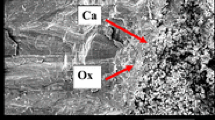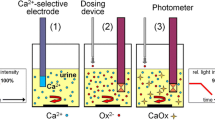Abstract
Monitoring of crystallization of calcium salts with ion-selective electrodes has turned out to be a very sensitive method. The difficulties of handling these electrodes in native whole urine and other biological fluids have been eliminated by new calcium analyzers, which clean and calibrate the electrodes after each measurement. To study crystallization kinetics, repeated calcium ion measurements have to be performed at regular intervals. For this purpose we have developed a special sampler and software. The sampler brings a thermostat-controlled crystallization chamber to the analyzer at preselected intervals. The computer directs and coordinates the sampler and the analyzer, stores the received results and prints out growth curves. Furthermore it calculates the half-time (h) and the maximum decrease of ionic calcium at infinite incubation time (ΔCa 2+∞ ). Both values are shown to characterize the growth of calcium oxalate monohydrate in urine. Results are obtained within 40 min.
Similar content being viewed by others
References
Baumann JM (1988) How to measure crystallization conditions in urine: a comparison of 7 methods. Urol Res 16:137
Bauman JM (1990) Rapid method of measuring the inhibition of calcium oxalate monohydrate growth in urine. Urol Res 18:219
Baumann JM, Lauber K, Lustenberger FX, Wacker M, Zingg EJ (1985) Crystallization conditions in urine of patients with idiopathic recurrent calcium nephrolithiasis and with hyperparathyreoidism. Urol Res 13:169
Brown CM, Ackermann DK, Purich DL (1994) EQUIL 93: a tool for experimental and clinical urolithiasis. Urol Res 22:119
Dürholt S, Schnur J (1990) Modula-2 Programmierhandbuch. Markt & Technik, Munich
Finlayson B, Reid F (1978) The expectation of free and fixed particles in urinary stone disease. Invest Urol 15:442
Kavanagh JP (1992) Methods for the study of calcium oxalate crystallization and their application to urolithiasis research. Scanning Electron Microsc 6:685
Robertson WG, Hughes H, Barkworth SA, Walker VR (1987) Competition between the known inhibitors and promotors of calcium oxalate crystallization in urine. In: Martelli A, Buli P, Marchesini B (eds) Inhibitors of crystallization in renal-lithiasis and their clinical application. Acta Medica Rome: 45
Rose GA (1987) Promoters of crystallization in urine. In: Martelli A, Buli P, Marchesini B (eds) Inhibitors of crystallization in renal-lithiasis and their clinical application. Acta Medica Rome: 93
Ryall RL, Hibberd CM, Marshall VR (1985) A method for studying inhibitory activity in whole urine. Urol Res 13:285
Ryall RL, Grover PK, Doyle IR, Harnett RM, Hibberd CM, Edyvane KA, Marshall VR (1987) The effect of macromolecules on the crystallization of calcium oxalate in human urine. In: Martelli A, Buli P, Marchesini B (eds) Inhibitors of crystallization in renal-lithiasis and their clinical application. Acta Medica Rome: 51
Will EJ, Bijvoet O, Blomen L, Van der Linden H (1983) Growth kinetics of calcium oxalate monohydrate. J Crys Growth 64:297
Wirth N (1991) Programmieren in Modula-2, 2nd edn. Springer, Berlin Heidelberg New york
Author information
Authors and Affiliations
Rights and permissions
About this article
Cite this article
Tassile, D., Affolter, B., Baumann, J.M. et al. Automated and computer-controlled method for the measurement of the crystallization of calcium oxalate monohydrate in urine. Urol. Res. 23, 407–411 (1995). https://doi.org/10.1007/BF00698744
Received:
Accepted:
Issue Date:
DOI: https://doi.org/10.1007/BF00698744




